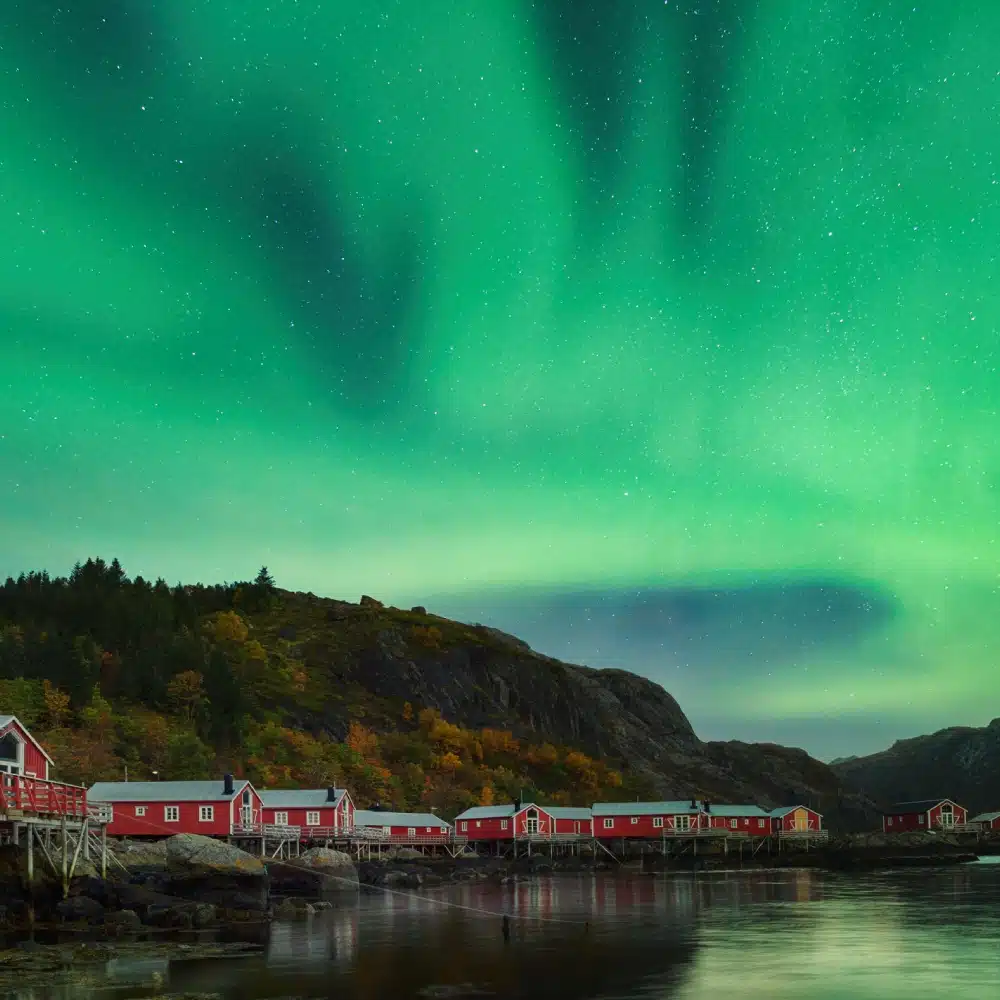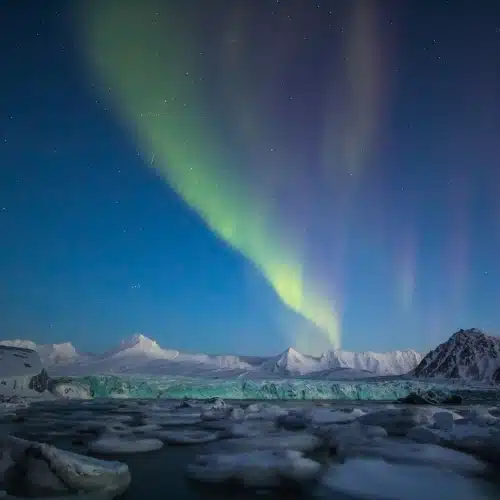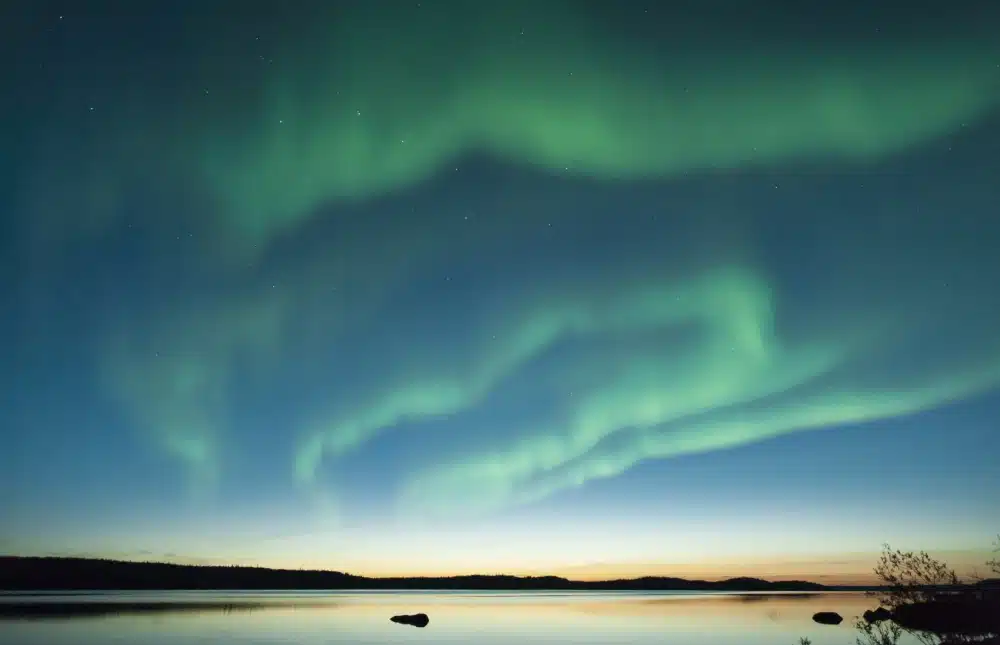A magical experience in the Far North
The polar auroras are a marvellous and irresistible invitation to reverie. Where to see northern lights? Head north to discover the best places to observe this fantastic astral phenomenon, from Alaska to Scandinavia passing through Canada and Greenland.
Feast your eyes on the northern lights inside the Arctic Circle
Travelling to the islands and icy expanses of the Arctic Ocean, inside the Arctic Circle, offers you fantastic opportunities to see the northern lights.
Ethereal painting in Spitsbergen
The glacier and mountain covered Norwegian archipelago of Svalbard, of which Spitsbergen is the main territory, seems like the perfect place to escape. Very few lucky people venture there. Here, the Northern Lights shimmer in the depths of the night and keep watch over the polar bears, reindeer and Arctic foxes that inhabit these remote lands.
Greenland under the Northern Lights
From the hypnotic Disko Bay to the icebergs of Savissivik, Greenland is one of the best observatories in the world for viewing such celestial phenomena. The Inuits call these incandescent lights arsaniit and lend them a mystical symbolism. They embody the reminiscence of the spirit of their ancestors and are an instrument for predicting weather changes.
Ultima Thule
Close to Smith Sound, Thule, the mythical land of the Far North – first mentioned in the writings of the Greek explorer Pytheas in the fourth century BC, who believed he had detected the limits of the world – offers a breathtaking backdrop for contemplating the Northern Lights. They rise above majestic glaciers, winding fjords and vast expanses of tundra in this isolated region on the shores of the Baffin Sea, creating a magical, almost unreal atmosphere.
The celestial dance on Baffin Island
Foxe Basin to the Gulf of Boothia and the towering cliffs of Sam Ford Fjord, part of Canada’s largest island, Baffin Island, offers an incomparable experience for watching the Northern Lights. In the heart of the Canadian Arctic, breathtaking panoramas of icy desert expanses light up under veils of green, red and purple light.
Watching the Northern Lights in Northern Europe
On the edge of the Arctic, Northern Europe is a must-see destination for admiring this iridescent spectacle.
Scandinavia, the essence of boreal
In Northern Europe, the northern lights illuminate the skies of Scandinavia, from the Norwegian fjords to the snow-covered forests of Lapland, from the picturesque villages of the Lofoten archipelago to North Cape. This natural phenomenon is a true symbol of Scandinavian culture, both revered and feared.
The northern lights in Scandinavian culture:
- In Finland, according to some legends, these lights come from sparks caused by a fox running past the snowy peaks.
- The Sami are wary of them and protect themselves from them by being as discreet as possible when they appear, to avoid bad luck befalling them.
- The Vikings see them as a reflection of the Valkyries’ armour or the “Bifrost”, the rainbow bridge that led fallen warriors to Valhalla

Iceland, the intersection of elements
This viking island is a top destination for hunters of the northern lights. The wild energy of its volcanic landscapes is matched by the gentleness of this great show of light. And how about relaxing in the hot springs under the celestial vault to add an extra touch of magic to this lunar setting?
Chasing the northern lights in North America
It’s not only in Europe that you can admire the Northern Lights. They also crown the peaks of America with their intense glow.
Ballet of light in the Alaskan skies
In winter, the Northern Lights irradiate the night skies of Alaska: temperate rainforests as far as the eye can see, towering mountains and glaciers, vast expanses of Arctic tundra… These cosmic lights represent the spirit of the sacred animals that watch over these remote lands, like the bear, the reindeer, the many cetaceans and the emblematic bald eagle.
When the sky dances over Quebec
It’s also possible to marvel at the northern lights in the far north-east of the American continent, from Quebec to the islands of the Gulf of St Lawrence. However, it’s best to stay away from the cities, and head for the charms of wild coastlines or majestic boreal forests, remote places where light pollution is minimal. If the conditions are right and the light intensity is strong enough, then the Northern Lights – a passage to the afterlife according to local legends – will rise like sails in the dark night.
When is the best time to see the northern lights?
Although they actually occur throughout the year, it is between late summer and early spring that we are most likely to be able to see them. Their splendour is most fully revealed on winter nights, when cold, dry cloudless skies offer the ideal conditions for observing them.
The cosmic and magical phenomena of the polar auroras
The polar auroras (or polar aurorae) form mystical waves that shoot out and spread across the sky in a spectrum of light, and are created by a conjunction of extraordinary natural phenomena. They are called the Northern Lights (aurora borealis) in the Northern Hemisphere and Southern Lights (aurora australis) in the Southern Hemisphere.
While these cosmic vagaries have fuelled countless tales and legends, their origins are easily explained. Polar auroras are in fact the result of a release of solar energy particles that reach the poles of the Earth, where its magnetic field is strongest. These intense lights occur in the ionosphere, the top layer of our atmosphere, a few hundred kilometres above our heads. It is only at this point that this great celestial spectacle takes place.
Photos credits: ©StudioPONANT; © iStock

PONANT takes you there
Marvel at the most astonishing natural phenomena with PONANT.



